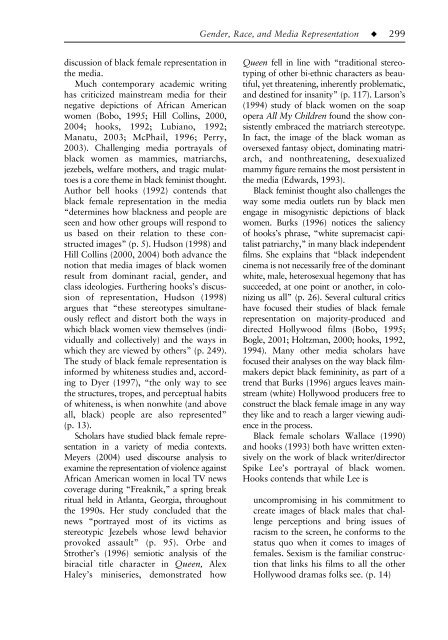Gender, race, and media representation - afghan
Gender, race, and media representation - afghan
Gender, race, and media representation - afghan
Create successful ePaper yourself
Turn your PDF publications into a flip-book with our unique Google optimized e-Paper software.
16-Dow-4973.qxd 6/11/2006 1:42 PM Page 299<br />
discussion of black female <strong>representation</strong> in<br />
the <strong>media</strong>.<br />
Much contemporary academic writing<br />
has criticized mainstream <strong>media</strong> for their<br />
negative depictions of African American<br />
women (Bobo, 1995; Hill Collins, 2000,<br />
2004; hooks, 1992; Lubiano, 1992;<br />
Manatu, 2003; McPhail, 1996; Perry,<br />
2003). Challenging <strong>media</strong> portrayals of<br />
black women as mammies, matriarchs,<br />
jezebels, welfare mothers, <strong>and</strong> tragic mulattoes<br />
is a core theme in black feminist thought.<br />
Author bell hooks (1992) contends that<br />
black female <strong>representation</strong> in the <strong>media</strong><br />
“determines how blackness <strong>and</strong> people are<br />
seen <strong>and</strong> how other groups will respond to<br />
us based on their relation to these constructed<br />
images” (p. 5). Hudson (1998) <strong>and</strong><br />
Hill Collins (2000, 2004) both advance the<br />
notion that <strong>media</strong> images of black women<br />
result from dominant racial, gender, <strong>and</strong><br />
class ideologies. Furthering hooks’s discussion<br />
of <strong>representation</strong>, Hudson (1998)<br />
argues that “these stereotypes simultaneously<br />
reflect <strong>and</strong> distort both the ways in<br />
which black women view themselves (individually<br />
<strong>and</strong> collectively) <strong>and</strong> the ways in<br />
which they are viewed by others” (p. 249).<br />
The study of black female <strong>representation</strong> is<br />
informed by whiteness studies <strong>and</strong>, according<br />
to Dyer (1997), “the only way to see<br />
the structures, tropes, <strong>and</strong> perceptual habits<br />
of whiteness, is when nonwhite (<strong>and</strong> above<br />
all, black) people are also represented”<br />
(p. 13).<br />
Scholars have studied black female <strong>representation</strong><br />
in a variety of <strong>media</strong> contexts.<br />
Meyers (2004) used discourse analysis to<br />
examine the <strong>representation</strong> of violence against<br />
African American women in local TV news<br />
coverage during “Freaknik,” a spring break<br />
ritual held in Atlanta, Georgia, throughout<br />
the 1990s. Her study concluded that the<br />
news “portrayed most of its victims as<br />
stereotypic Jezebels whose lewd behavior<br />
provoked assault” (p. 95). Orbe <strong>and</strong><br />
Strother’s (1996) semiotic analysis of the<br />
biracial title character in Queen, Alex<br />
Haley’s miniseries, demonstrated how<br />
<strong>Gender</strong>, Race, <strong>and</strong> Media Representation–––◆–––299<br />
Queen fell in line with “traditional stereotyping<br />
of other bi-ethnic characters as beautiful,<br />
yet threatening, inherently problematic,<br />
<strong>and</strong> destined for insanity” (p. 117). Larson’s<br />
(1994) study of black women on the soap<br />
opera All My Children found the show consistently<br />
emb<strong>race</strong>d the matriarch stereotype.<br />
In fact, the image of the black woman as<br />
oversexed fantasy object, dominating matriarch,<br />
<strong>and</strong> nonthreatening, desexualized<br />
mammy figure remains the most persistent in<br />
the <strong>media</strong> (Edwards, 1993).<br />
Black feminist thought also challenges the<br />
way some <strong>media</strong> outlets run by black men<br />
engage in misogynistic depictions of black<br />
women. Burks (1996) notices the saliency<br />
of hooks’s phrase, “white supremacist capitalist<br />
patriarchy,” in many black independent<br />
films. She explains that “black independent<br />
cinema is not necessarily free of the dominant<br />
white, male, heterosexual hegemony that has<br />
succeeded, at one point or another, in colonizing<br />
us all” (p. 26). Several cultural critics<br />
have focused their studies of black female<br />
<strong>representation</strong> on majority-produced <strong>and</strong><br />
directed Hollywood films (Bobo, 1995;<br />
Bogle, 2001; Holtzman, 2000; hooks, 1992,<br />
1994). Many other <strong>media</strong> scholars have<br />
focused their analyses on the way black filmmakers<br />
depict black femininity, as part of a<br />
trend that Burks (1996) argues leaves mainstream<br />
(white) Hollywood producers free to<br />
construct the black female image in any way<br />
they like <strong>and</strong> to reach a larger viewing audience<br />
in the process.<br />
Black female scholars Wallace (1990)<br />
<strong>and</strong> hooks (1993) both have written extensively<br />
on the work of black writer/director<br />
Spike Lee’s portrayal of black women.<br />
Hooks contends that while Lee is<br />
uncompromising in his commitment to<br />
create images of black males that challenge<br />
perceptions <strong>and</strong> bring issues of<br />
racism to the screen, he conforms to the<br />
status quo when it comes to images of<br />
females. Sexism is the familiar construction<br />
that links his films to all the other<br />
Hollywood dramas folks see. (p. 14)




